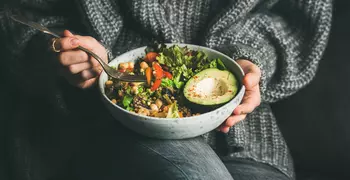What Experts Recommend for Healthy Eating

In his book In Defense of Food, Michael Pollan offers three simple, easy-to-remember “rules” for eating:
 Eat food.
Eat food.- Not too much.
- Mostly plants.
These guidelines are very aligned with the 2015 USDA recommendations and those developed by Harvard’s Healthy Eating Plate, which include choosing whole grains, eating lean protein like fish and chicken instead of red meat, drinking plenty of water, using healthy oils, and filling almost half your plate with healthy produce.
Here are general guidelines that apply to everyone and are important for good health.
Know your healthy body weight
Because there is such strong evidence linking obesity to many chronic or acute diseases, the World Health Organization and the U.S. Department of Health and Human Services recommend that you aim for a healthy body weight with a body mass index (BMI) between 18.5 and 25. BMI indicates an individual's weight status in relation to height, and it helps give a sense of a healthy ratio between the two. It doesn't apply to children, the elderly, or the very athletic.
Calculate your BMI with this tool from the National Heart, Lung, and Blood Institute.
Combine healthy eating with exercise
Studies show that diet alone is not as effective in achieving a healthy body weight as diet combined with exercise. Physical activity has many other health benefits as well. See the Fitness and Exercise section for recommendations on how to be physically active each day. Even relatively small weight loss can make a difference in health by reducing blood pressure and improving glucose tolerance and blood lipids.
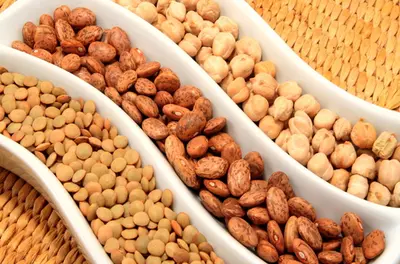
Kitchen staples
Stock these foods in your pantry for quick, healthy meals.
You can quickly cook some pasta and add a pesto sauce and some pine nuts or walnuts for a basic meal. Or you can cook couscous and add chickpeas, raisins, and a curry sauce. Add fresh vegetables, such as tomatoes or zucchini to the pasta, or cauliflower and shredded carrots to the couscous, for additional health and enjoyment.
- A variety of grains such as millet, buckwheat, oats, barley, brown rice, and quinoa
- Boxed rice, couscous, risotto
- Dried pastas, such rotini, penne, and spaghetti
- Canned salmon, tuna, and sardines
- Olive oil, sesame oil, canola oil, coconut oil
- Vinegars, such as balsamic and red wine vinegar
- Jarred olives, artichoke hearts, capers, sun dried tomatoes, and roasted red peppers
- Black and green olives
- Canned whole, diced, crushed, and stewed tomatoes and tomato paste
- Pumpkin seeds, sunflower seeds, and sesame seeds
- Almonds, pecans, walnuts, and pine nuts
- Dried herbs, particularly thyme, basil, and oregano
- Sea salt
- Tamari, salsa, and other bottled sauces, such as an apricot chipotle, pesto, curry or Asian sauce
- Canned beans, such as cannelloni, black, pinto, chickpeas, or great northern
- Cartons and cans of soup
- Cartons and cans of vegetable and chicken broth and stock
- Canned pineapple, jarred applesauce, preserves, and jams
- Coconut and other dried fruit, such as apricots, plums, and golden raisins
- Honey or agave

How to eat mindfully
Try these three strategies to help you eat mindfully.
Strategy 1
In Eating Mindfully, Susan Albers recommends starting with one mealtime: breakfast, lunch, or dinner.
Choose a specific location to eat, such as your table or the lunchroom at work.
Sit quietly. Don't get up, and don't answer the phone.
Have all the food you intend to eat on the table in front of you before starting.
To be mindful you must give your full attention to your eating. You must focus on the process of eating and enjoying your meal.
Strategy 2
Susan Albers suggests that one way to slow down the process of eating is to challenge the way you have always done it.
For example, try eating using a pair of chopsticks instead of your customary utensils. This will force you to take smaller portions, eat more slowly, and look at your food more closely. Other strategies include eating with your non-dominant hand, chewing your food 30 to 50 times per bite, or trying to make the portion of food you've taken for the meal last 20 minutes.
Observe the sensation of picking up the food and placing it in your mouth.
Strategy 3
In Coming to Our Senses, mindfulness guru Jon Kabat Zinn says, "When we taste with attention, even the simplest foods provide a universe of sensory experience, awakening us to them."
The Raisin Consciousness is an exercise Jon Kabat Zinn uses with his clients as a first meditation. The exercise is based on Buddhist teachings. (Note: if you don't like raisins, you can use another fruit or nut.)
Raisin Meditation
- Sit comfortably in a chair.
- Place a raisin in your hand.
- Examine the raisin as if you had never seen it before.
- Imagine it as its "plump self" growing on the vine surrounded by nature.
- As you look at the raisin, become conscious of what you see: the shape, texture, color, size. Is it hard or soft?
- Bring the raisin to your nose and smell it.
- Are you anticipating eating the raisin? Is it difficult not to just pop it in your mouth?
- How does the raisin feel? How small it is in your hand?
- Place the raisin in your mouth. Become aware of what your tongue is doing.
- Bite ever so lightly into the raisin. Feel its squishiness.
- Chew three times and then stop.
- Describe the flavor of the raisin. What is the texture?
- As you complete chewing, swallow the raisin.
- Sit quietly, breathing, aware of what you are sensing.
Kabat Zinn discusses the experience thus:
"The raisin exercise dispels all previous concepts we may be harboring about meditation. It immediately places it in the realm of the ordinary, the everyday, the world you already know but are now going to know differently. Eating one raisin very, very slowly allows you to drop right into the knowing in ways that are effortless, totally natural, and entirely beyond words and thinking. Such an exercise delivers wakefulness immediately. There is in this moment only tasting."
Albers, S. (2003). Eating Mindfully. Oakland, Calif.: New Harbinger Publications, Inc.
Kabat Zinn, J. (2005). Coming to Our Senses. New York: Hyperion.
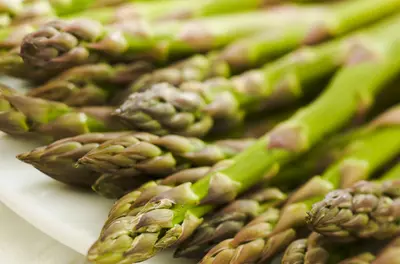
Healthy recipes for greens
Need more green in your life? Check out these recipes.
All recipes are from Cooking Up the Good Life by Jenny Breen. Published by University of Minnesota Press, http://www.upress.umn.edu.
Garlic Almond Kale (vegan)
Serves 6-8
This salad can be served hot or cold, and it's delicious either way. The well-sautéed onions and wilted kale-or other greens as available in season-are a simple combination enhanced with the subtle flavor of sesame oil.
The Family Kitchen: Children can do the rinsing and draining of the greens, and they'll have fun tearing the greens off of the stems and into bite-sized shapes.

2 tablespoons olive oil
2 tablespoons sesame oil
1 medium onion, thinly sliced
3 large bunches kale, chard, or other leaves, torn to half-dollar-sized pieces
¼ cup tamari
1 cup roasted almonds, roughly chopped
¼ cup chopped garlic (about 6 large cloves)
Heat oil and add onion, kale, and tamari and sauté for 1- 2 minutes over medium heat. Add garlic and almonds to greens, and continue to sauté for another 1-2 minutes. Remove from heat. Serve hot or chilled.
Early Greens with Miso Dressing and Toasted Almonds (vegan)
Serves 8 to 10
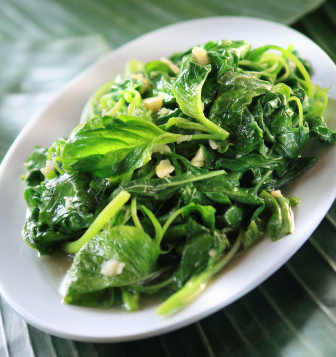
People love this combination of sweet and spicy, savory and sour. The dressing is also delicious on just about any vegetable or proteins like tofu and fish.
The Family Kitchen: Crushing almonds can be fun. You don't need to use a knife or a tool at all. My favorite way to do it is under the bottom of a jar. Kids can also use a rolling pin.
2 lbs. assorted early greens (arugula, mustard, spinach, etc.), washed and dried
2 medium onions OR 2 washed leeks, sliced
6 cloves garlic, minced
1 inch ginger, peeled and minced
2 tablespoons olive oil
2 tablespoons toasted sesame oil
2 cups sliced or crushed almonds, toasted
Miso Dressing:
1/3 cup rice vinegar
2 tablespoons honey or maple syrup
2 tablespoons stone ground mustard
½ cup miso paste
2 tablespoons toasted sesame oil
1/3 cup olive oil
2 teaspoons tamari
Heat oils in saucepan, add onions and sauté for 2-3 minutes until soft, then add garlic and ginger. Add the greens by the handful, stirring constantly. Sauté until all the greens are added and they have wilted into a bright green (about 2 minutes). Remove immediately from heat and place in a large bowl. Allow the mixture to cool, and add the toasted almonds. In a small bowl, whisk together all the dressing ingredients, then toss with vegetable mixture.
Brussels Sprouts with Honey Horseradish Sauce (vegan, except honey)
Serves 8 to 10
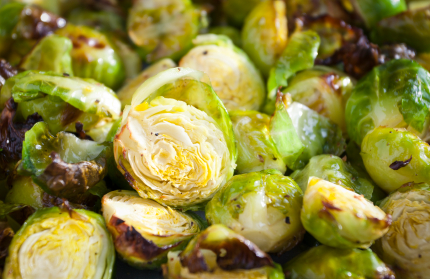
Brussels sprouts are like fun little mini-cabbages-slightly bitter and light and leafy at the same time. This sauce is what makes them work here. The sprouts, combined with the steady flavor of potato, are the perfect vehicle for this beautiful balance of spicy and sweet.
1 lb. Brussels sprouts, halved
3 medium sweet potatoes, cleaned and sliced thinly
2 leeks, cleaned and sliced thinly
2 tablespoons olive oil
Horseradish sauce:
¼ cup olive oil
¼ cup mustard
¼ cup horseradish
2/3 cup honey
¼ cup cider vinegar
4 cloves garlic, minced
1 inch ginger, minced
½ teaspoon salt
Preheat oven to 385°F. Combine sauce ingredients and set aside. Clean and cut Brussels sprouts, sweet potatoes, and leeks and coat with olive oil. Place in large baking pan, pour sauce over vegetables, and coat well. Bake for about 20 minutes, until vegetables are tender and brightly colored.
Asparagus with Citrus and Olive Marinade (vegan, except honey)
Serves 8 to 10
 The combination of lemon and orange with Mediterranean enhance the freshness and spring feeling of this marinade. Add the slightly bitter, melt-in-your-mouth tenderness of fresh (and fleeting) local asparagus, and it is the perfect taste of the season.
The combination of lemon and orange with Mediterranean enhance the freshness and spring feeling of this marinade. Add the slightly bitter, melt-in-your-mouth tenderness of fresh (and fleeting) local asparagus, and it is the perfect taste of the season.
The Family Kitchen: In addition to breaking the asparagus just right, kids can help peel and chop the citrus and squeeze the juice. They will enjoy the sweet and tangy smell and the sticky juice on their hands, especially if they can lick it off.
2 lbs. asparagus
2 tablespoons olive oil
¼ cup water
½ red onion, sliced very thinly
Marinade:
Juice of ½ lemon
2 tablespoons honey
¼ cup olive oil
¼ cup champagne vinegar
2 teaspoons salt
4 cloves garlic, minced
2 tablespoons fresh thyme leaves, minced
2 very ripe navel oranges or tangerines peeled and seeded, roughly chopped with juice
1 cup olives, pitted and chopped
Gently break off about ¼ the asparagus stems and discard the trimmings (they will naturally break at the appropriate spot). Cut the asparagus into thirds and set aside. Prepare the marinade by combining the lemon juice, honey, ¼ cup olive oil, vinegar, salt, garlic, and thyme. Whisk well. Add oranges and juice, and olives, mix and set aside. In saucepan, heat water and 2 tablespoons olive oil. When almost boiling, place asparagus and red onion in pan, cover and steam until asparagus is bright green and tender--about 2 to 3 minutes. When ready, remove onions and asparagus from pan and cover with marinade. Chill for up to 4 hours.
Follow dietary guidelines
Whether you are working to lose or maintain weight, you should make healthy food choices following the Dietary Guidelines for Americans, developed by the U.S. Department of Health and Human Services and the U.S. Department of Agriculture. These guidelines will improve your health, help you meet your nutrient requirements, and reduce your risk of chronic disease.
Learn to see food as medicine The dietary guidelines recommend that you get the most nutrition out of the calories you eat. Calculate your calorie needs.
To simplify healthy eating, the U.S. Department of Agriculture has replaced the traditional food pyramid with the Choose My Plate graphic. We recommend the Harvard School of Public Health version, called the Healthy Eating Plate, which points consumers to the healthiest choices in the major food groups based on the best scientific evidence.
Drink water
 It is a common recommendation to drink 8 to 10 glasses of water a day to help your body's biological processes, especially carrying nutrients to cells and eliminating wastes.
It is a common recommendation to drink 8 to 10 glasses of water a day to help your body's biological processes, especially carrying nutrients to cells and eliminating wastes.
The Institute of Medicine (IOM) advises men to consume roughly 3.7 liters (about 16 cups) of water a day and women to consume 2.7 liters (about 12 cups) of water a day.
- Eighty percent of this should come from drinking water and other beverages, (but not soda, coffee, or alcohol).
- The remaining 20% should come from foods—especially fruits and vegetables, which are 70% to 95% water.
Your water needs depend on many factors, including your health, how active you are, and where you live. It's generally not a good idea to use thirst alone as a guide for when to drink. By the time you become thirsty, you may already be slightly dehydrated. It is especially important for older adults to drink water before becoming thirsty, because your thirst sense is diminished as you get older.
Pay attention to your eating patterns
How, when, and where do you eat? If you're like many Americans, you may often eat meals while doing something else: driving, talking on the phone, watching television, or reading. In short, you may pay little attention to your food. As a result:
- You may not always fully taste and enjoy your food.
- You may eat more than you need.
- You may sometimes suffer from indigestion or other gastrointestinal symptoms.
Learn about why being mindful while eating matters.
Notice (and avoid) the influence of the "food giants"
In Salt Sugar Fat: How the Food Giants Hooked Us, reporter Michael Moss describes how executives at large food corporations have figured out the science of getting people to buy more of their products. In short, many processed foods are not designed to enhance wellbeing, but to exploit natural cravings for salt, sugar, and fat—and when coupled with colorful, attractive advertising, many unhealthy foods such as colas and sugary cereals become irresistible staples in the American diet.
 The grocery store is a good place to practice mindful shopping. Check the ingredients label—many companies have begun to shovel harmful amounts of sugar and salt into foods you wouldn’t naturally suspect, such as spaghetti sauce, granola bars, and yogurt. Make purchase decisions based on USDA dietary guidelines: buy “whole foods,” such as fruits and vegetables, and skip processed foods, no matter how tempting and flashy their packaging may be. This is especially important if you have children, as much of the food giants’ marketing is aimed at exploiting the vulnerable willpower of young people.
The grocery store is a good place to practice mindful shopping. Check the ingredients label—many companies have begun to shovel harmful amounts of sugar and salt into foods you wouldn’t naturally suspect, such as spaghetti sauce, granola bars, and yogurt. Make purchase decisions based on USDA dietary guidelines: buy “whole foods,” such as fruits and vegetables, and skip processed foods, no matter how tempting and flashy their packaging may be. This is especially important if you have children, as much of the food giants’ marketing is aimed at exploiting the vulnerable willpower of young people.
Eat with others
Apart from the biological effects of eating on the run, there are social, psychological, and spiritual effects. Fast-food habits can deny you the benefits gained from preparing foods with mindfulness, appreciation, and care, and eating with others in a relaxing atmosphere.
Research demonstrates that the social component to eating is critically important to health outcomes and wellbeing. A 2011 study showed that children and adolescents who eat meals with their family 3 or more times each week increase their likelihood of developing healthy eating habits and maintaining a normal weight. Another study by a team at the University of Minnesota found that family mealtimes also decreased risk for substance abuse, sexual intercourse, depression, eating disorders, and poor academic performance among adolescents. It stands to reason that eating with others you care about is beneficial to everyone.
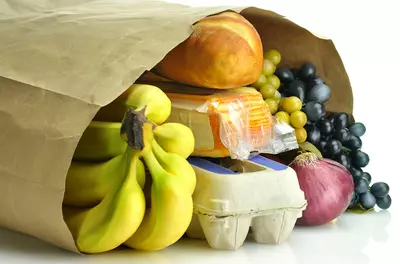
Cooking for body and spirit
Jenny Breen, a chef, nutritionist, and faculty of our Food Matters: Cooking as Though Your Life Depended On It course for health professionals and others, presents quick ways to cook meals that feed the body and spirit in this webinar.
http://health.gov/dietaryguidelines/2015/
http://www.health.harvard.edu/plate/healthy-eating-plate
http://www.who.int/gho/ncd/risk_factors/overweight/en/
http://www.letsmove.gov/obesity
Eisenberg, M.E., Olson, R.E., Neumark-Sztainer, D., Story, M., Bearinger, L.H. (2004). Correlations between family meals and psychosocial well-being among adolescents. Archives of Pediatrics and Adolescent Medicine, 158, 792-796.
Hammons, A.J., Fiese, B.H. (2011). Is frequency of shared family meals related to the nutritional health of children and adolescents? Pediatrics; 127(6), e1565-74.
Moss, M. (2013). Salt sugar fat: How the food giants hooked us. New York: Random House.
Pollan, M. (2009). Food rules. New York: Penguin Group.


